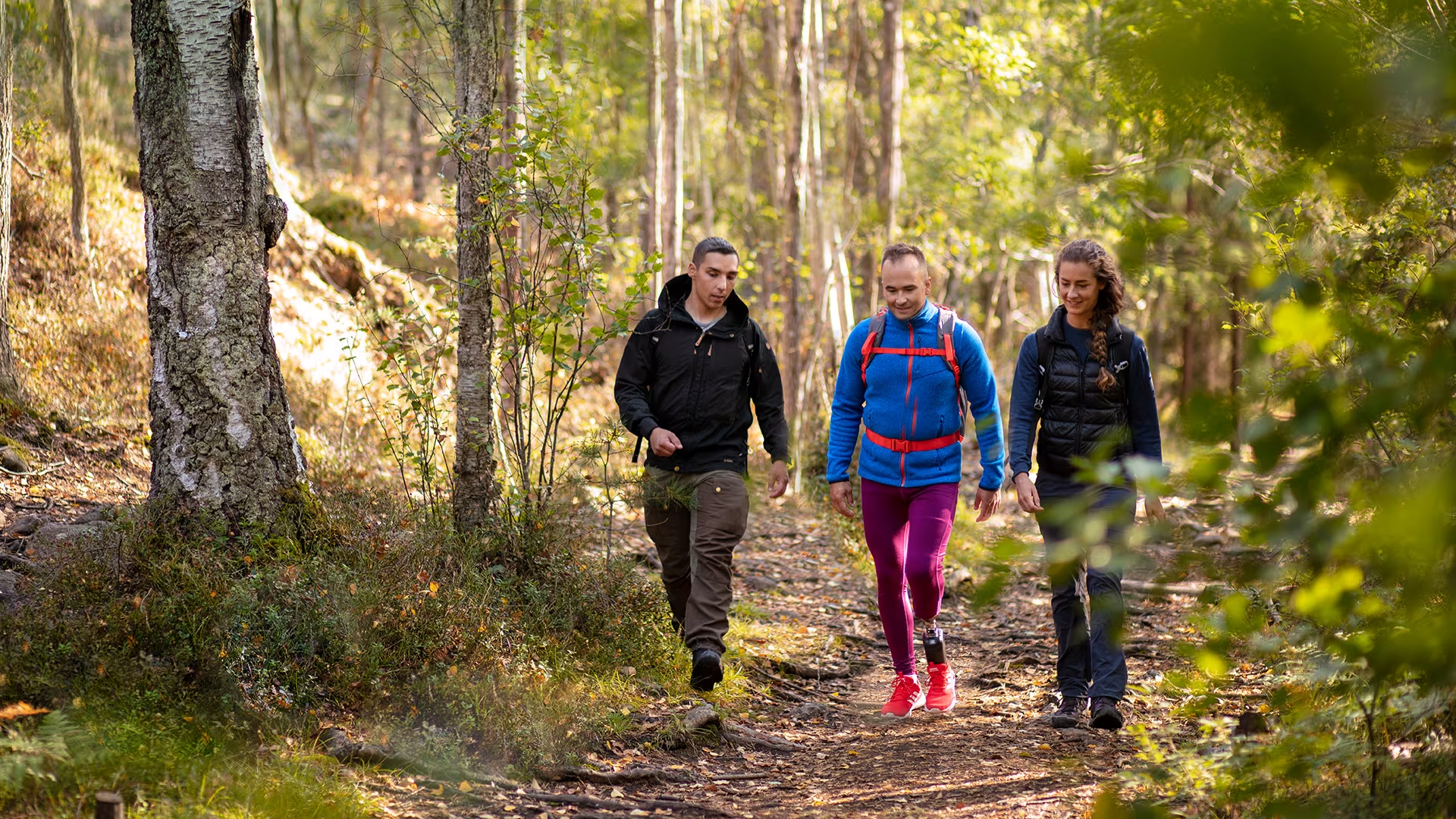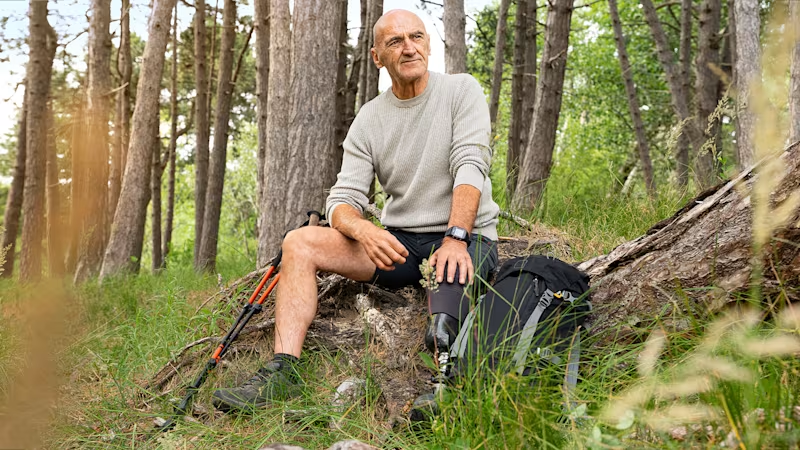


Finding the best foot for you
It’s so much more than a foot. It’s your foundation.
The prosthetic foot makes everything else possible. Whether you‘re an above or below knee amputee, the quality and performance of your whole prosthesis will be impacted by the quality and performance of the prosthetic foot.
With a wide range of Ottobock prosthetic feet you can be sure that together with your Prosthetist you will find the one prosthetic foot fitting to your personal needs. Whether it is a foot made out of carbon or it is a microprocessor controlled foot – our whole portfolio is based on the same idea: building a foundation. We take our responsibility seriously. When choosing a prosthetic foot from Ottobock, you can be sure that each one is designed with passion, in compliance with highest quality standards and always with your needs in mind.
This is what you can rely on
With the widest range of prosthetic feet at Ottobock, you can be sure to find the one foot fitting to your personal needs. Whether it is a foot made out of carbon or it is a microprocessor controlled foot - our whole portfolio is based on the same idea: building a foundation. Find out about our different categories of feet.

Heritage
For generations, Ottobock feet have helped define what’s possible with a lower limb prosthesis. With every step, our feet carry on the traditions of craftsmanship, invention and passion – that continue to set our products apart.
For generations, Ottobock feet have helped define what’s possible with a lower limb prosthesis. With every step, our feet carry on the traditions of craftsmanship, invention and passion – that continue to set our products apart.

Quality
Every detail within a prosthetic foot can make a difference for your daily life. That’s why when designing a foot, we treat every detail like it’s the most important one. Built to the same exceptional standard, our feet start and end with your needs
Every detail within a prosthetic foot can make a difference for your daily life. That’s why when designing a foot, we treat every detail like it’s the most important one. Built to the same exceptional standard, our feet start and end with your needs

Trust
If you decide together with your Prosthetist for an Ottobock foot, you can trust that you have chosen a foot that has been meticulously designed, rigorously evaluated and preferred by amputees around the world.
If you decide together with your Prosthetist for an Ottobock foot, you can trust that you have chosen a foot that has been meticulously designed, rigorously evaluated and preferred by amputees around the world.
Our portfolio and (your role in) the fitting process
Each user is different and each user has different individual habits, preferences and goals. To meet your individual requirements and those of other users, it is not purposeful to provide one prosthetic foot for everyone but to have different prosthetic feet for different user needs. Our prosthetic feet cater to your requirements on an individual level.
Apart from giving you more insights into our prosthetic foot portfolio, we put together some useful information on selection criteria, prosthetic feet in general and FAQs for you. We believe the more knowledge you have of how your Prosthetist will choose the best foot for you, the more actively you can participate in your fitting. This will ensure you are both happy with the end result.
Carbon Feet

Evanto
Designed for moderately active and active individuals, Evanto offers exceptional multi-axial flexibility. Its ability to adapt to uneven terrain ensures that you experience both comfort and confidence in every step.
Designed for moderately active and active individuals, Evanto offers exceptional multi-axial flexibility. Its ability to adapt to uneven terrain ensures that you experience both comfort and confidence in every step.

Taleo
Designed for active individuals who navigate varied indoor and outdoor environments and place a high value on effortless walking and the ability to go wherever life takes them.
Designed for active individuals who navigate varied indoor and outdoor environments and place a high value on effortless walking and the ability to go wherever life takes them.

Trias
Designed for moderately active individuals who navigate indoor and familiar outdoor environments and place a high value on consistent stability when walking.
Designed for moderately active individuals who navigate indoor and familiar outdoor environments and place a high value on consistent stability when walking.

Terion K2
Designed for less active individuals who mainly navigate indoor environments and will utilise a walking aid for outdoor ambulation and place a high value on dependable support from their prosthetic foot.
Designed for less active individuals who mainly navigate indoor environments and will utilise a walking aid for outdoor ambulation and place a high value on dependable support from their prosthetic foot.

Triton
Designed for highly active individuals who navigate varied indoor and outdoor environments and place a high value on uncompromised response and control even when performing high impact activities.
Designed for highly active individuals who navigate varied indoor and outdoor environments and place a high value on uncompromised response and control even when performing high impact activities.
Mechatronic feet

Meridium
Designed for moderately active individuals who navigate various indoor and outdoor environments and place a high value on intuitive adaptation that replicates natural movement.
Designed for moderately active individuals who navigate various indoor and outdoor environments and place a high value on intuitive adaptation that replicates natural movement.

Empower
Designed for highly active individuals who navigate various indoor and outdoor environments and place a high value on the ability to cover longer distances and walk at a higher walking speed.
Designed for highly active individuals who navigate various indoor and outdoor environments and place a high value on the ability to cover longer distances and walk at a higher walking speed.
Sports Feet

Runner
Designed for everyone who wants to use the same running blade that even elite athletes use.
Designed for everyone who wants to use the same running blade that even elite athletes use.

Challenger
Designed for everyone who participates in recreational sports while performing agile and powerful movements.
Designed for everyone who participates in recreational sports while performing agile and powerful movements.
General information on prosthetic feet
Designing prosthetic foot systems is challenging. It’s very difficult to reproduce the complex workings of the human foot and ankle. Ideally the foot will be light because its weight is added to the rest of the prosthetic leg. If the foot is too heavy and the suspension of the prosthesis is not appropriate, the connection to the socket and your limb will be affected and also the overall function of the prosthesis.
A good prosthetic foot should also be strong, as it will be taking on large forces and torque as you walk and run. Feet must also be small enough to fit within a foot shell, a cosmetic covering for the prosthetic foot, and thus fit within a shoe. Being light, strong and small whilst still remaining functional and durable is the challenge.
Early designs for prosthetic feet were often a solid piece of wood. A similar design, the SACH (solid-ankle-cushioned-heel) is still in use because of its sturdy function. It is especially useful for individuals with lower activity levels. A SACH foot typically has a rigid inner structure (wood or plastic) surrounded by a compressible foam cosmetic shell.
Today’s more sophisticated feet add more functions and are secured inside a cosmetic shell. Most people never see their prosthetic foot without this exterior shell. The cosmetic shell stretches around the prosthetic foot and serves two purposes:
It makes your prosthetic foot look like an anatomical foot.
It fits snuggly in your shoe.
What’s inside the shell can vary dramatically. Prosthetic feet are designed to meet the needs of your lifestyle and activity level. Here are some factors to consider.
Materials
The materials in a prosthetic foot differ by activity level. Wood, plastic and foam are usually found in feet designed for individuals who have low activity levels and require stability. Lightweight carbon fibre feet meet the functional needs of active individuals since they are built for shock absorption and energy efficiency.

Comfort
A prosthetic foot has to feel good for you to meet your activity goals. Comfort allows you to be more active and the function of your prosthetic foot directly affects comfort.

Function
Prosthetic feet are designed to mimic a human foot at a specific activity level. For lower activity individuals, a prosthetic foot is designed to provide stability and balance. For those who are most active, a prosthetic foot must mimic the natural foot during the act of walking. It must act as a shock absorber as you strike your heel to the ground, adapt to uneven terrain, provide a smooth rollover from heel to toe, and provide a rigid lever for propelling forward when you finish your step (“toe-off”).

Multi-axial motion
Some prosthetic feet are designed to mimic the ankle which allows the foot to move in multiple planes. Multi-axial capability in a foot allows the foot to absorb varying terrain by moving in all directions. These motions are forward to back, side to side and rotation around the ankle. Multi-axial motion is needed to walk comfortably and confidently on uneven ground where your foot must adapt to whatever it encounters.

Energy storage
A carbon fibre foot is able to store and return energy while walking and literally gives you a spring in your step. The carbon fibre acts as a spring which compresses as you apply weight and then propels you forward as you roll off the toe of the foot when the energy is returned. Some prosthetic feet have one spring in the heel and a second spring in the forefoot: just what you need for walking at different speeds, running, climbing hills or descending stairs with a secure, confident stride. With carbon fibre, the longer the spring, the more energy it can store and the more responsive the foot will be.

How you and your Prosthetist select the right prosthetic foot for you
Choosing a prosthetic foot that best suits your personal requirements, needs and goals is a complex task. Your Prosthetist is an expert in this field. Thanks to his education, experience and biomechanical knowledge, he will choose the prosthetic foot that helps achieve the best possible fitting outcome for you individually. The information provided in this section only serves as a guidance. Please contact your Prosthetist if you have more detailed questions.
Amputation Level
Your level of amputation will be one of the first things that needs to be looked at when choosing the components in a prosthesis. An above knee amputation requires a prosthetic knee joint and the type of knee joint will help to define the appropriate prosthetic foot. This is where your Prosthetist will assess the functions of the prosthetic knee joint and recommend an appropriate prosthetic foot. Because the natural knee joint is intact after a below knee amputation, your Prosthetist will consider factors like length of the residual limb, strength and range of motion when recommending an appropriate prosthetic foot.

Activity Levels
Manufacturers categorise prosthetic feet by the user’s activity level – also called mobility grade. This means that not every prosthetic foot can be used by every user. Selecting a prosthesis that matches your activity level will maximise your mobility and your quality of life. Here are some very basic indications for identifying your activity level. If you are on the border between two activity levels, your Prosthetist will consider multiple products to assess the one that is best for you.
Body Weight
Prosthetic feet are designed for a specific weight range. To ensure that a prosthetic foot performs well for you, your Prosthetist will choose one suited to your weight class.

Build Height
Prosthetic feet vary in height. We call the height of a prosthetic foot build height. Your height and the length of your residual limb as a below knee amputee will determine the space you have for a prosthetic foot and what is the appropriate build height for the prosthetic foot. As an above knee amputee, the length of the prosthetic knee joint will be an additional factor to consider for the build height of the prosthetic foot.

Foot Size
Like human feet, prosthetic feet differ in length/size. Prosthetic feet are sized by cm rather than standard shoe sizes. Every foot is available in a specific range of sizes. There are prosthetic feet that come in sizes for children while others are even sized for large adults. Ottobock running blades and speciality sports feet often have a a single size.

Personal Factors
Apart from all the technical selection criteria, your Prosthetist will keep in mind your personal needs, living situation and goals when choosing a prosthetic foot for you. These factors might be the desire to participate in sports activities or the ability to paint your toenails. These are of great importance because your prosthetic foot should feel like an extension of yourself.








